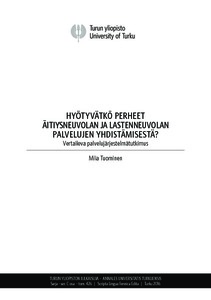| dc.contributor | Kliininen laitos. Kansanterveystiede | - |
| dc.contributor.author | Tuominen, Miia | |
| dc.date.accessioned | 2016-09-07T05:39:09Z | |
| dc.date.available | 2016-09-07T05:39:09Z | |
| dc.date.issued | 2016-09-30 | |
| dc.identifier | ISBN 978-951-29-6569-4 | - |
| dc.identifier.uri | http://www.utupub.fi/handle/10024/125185 | |
| dc.description.abstract | Tutkimuksen tarkoituksena oli selvittää neuvolapalvelujen organisointitavan, eli neuvolamallin, merkitystä neuvolan asiakkaille. Tutkimuksen tavoitteena oli kuvata ja verrata kahta eri neuvolamallia – äitiysneuvolaa ja lastenneuvolaa sekä yhdistettyä äitiys- ja lastenneuvolaa – käyttäneiden a) naisten äitiyshuollon palveluiden käyttöä, raskautta ja synnytystä sekä vastasyntyneen terveyttä kuvaavia syntymärekisterin osoittimia, b) vanhempien neuvola-palvelukokemuksia, neuvolapalvelujen käyttöä sekä tulevaisuuden neuvolapalveluun liittyviä toiveita, ja c) vanhempien itsearvioimaa vanhemmuuden kyvykkyyttä yleisesti sekä masennusoireita ja yksinäisyyttä kokevien vanhempien osalta.
Tutkimus on osa Turun yliopiston Lapsi- ja nuorisotutkimuskeskuksen Varsinais-Suomen sairaanhoitopiirin alueella toteutuvaa Hyvän kasvun avaimet -seurantatutkimusta. Tutkittavan perusjoukon muodostivat Hyvän Kasvun avaimet -seurantatutkimukseen 1.9.2007–31.3.2010 osallistuneet perheet (N = 1797) sekä 1.1.2009–31.12.2009 Varsinais-Suomen sairaanhoitopiirissä synnyttäneet naiset (N = 4480). Aineisto koostui kyselylomaketiedoista (mittauspisteet 4 kuukautta lapsen syntymän jälkeen n = 995 äitiä, n = 789 isää ja 18 kuukautta lapsen syntymän jälkeen n = 987 äitiä, n = 829 isää) ja syntymärekisterin tiedoista (n = 2741), joita täydennettiin neuvoloiden esimiehiltä kerätyllä tiedolla neuvolapalvelun organisointitavasta.
Tutkimuksessa äitiyshuollon palvelujen käyttöä sekä äidin ja lapsen terveyttä kuvaavissa syntymärekisterin osoittimissa ei todettu kliinisesti merkittäviä eroja äitiysneuvolan ja yhdistetyn äitiys- ja lastenneuvolan asiakkaiden välillä. Sen sijaan vanhempien kokemuksia verrattaessa neuvolamallien välillä havaittiin eroja. Tutkimustulokset osoittivat, että yhdistettyä äitiys- ja lastenneuvolaa käyttäneet äidit ja isät olivat tyytyväisempiä useaan neuvolapalvelun osa-alueeseen ja saivat enemmän kotikäyntejä kuin erillisen äitiysneuvolan ja lastenneuvolan asiakasvanhemmat. Yhdistelmäneuvolassa sisällöltään ja määrältään paremmaksi koetut palvelun osa-alueet painottuivat neuvolan tarjoamaan tukeen. Yhdistetyssä äitiys- ja lastenneuvolassa koettu terveydenhoitajan ja perheen välinen hoidon jatkuvuus suojasi äitien ja isien vanhemmuuden kyvykkyyttä masennusoireiden vaikutuksilta.
Tutkimustulosten mukaan hoidon jatkuvuuden mahdollistava yhdistetty äitiys- ja lastenneuvola on vaikuttava ja perheille hyödyllinen tapa tuottaa neuvolapalvelut. Tulokset tukevat aikaisempaa tutkimusnäyttöä terveydenhuollon ammattihenkilön ja asiakkaan välisen hoidon jatkuvuuden hyödyistä. | fi |
| dc.description.abstract | Do families benefit from the integration of the maternity health clinic and child health clinic services? Comparative health service research
The purpose of the study was to clarify the significance of the organisational model of the maternity and child health clinic services for the customers of these clinics. The aim of the study was to describe and compare the services of two different maternity and child health clinic models — a separate maternity clinic and child health clinic and an integrated maternity & child health clinic model from the point of view of mothers and fathers. First, based on the Finnish Medical Birth Register, women’s maternity care service utilisation, and certain maternal and perinatal health outcomes were studied. Second, the parents’ maternity and child health clinic service experiences and wishes regarding the future service were explored. Third, the parenting self-efficacy of the parents, in relation with parents’ experienced loneliness and depressive symptoms were studied.
The study is a part of the multidisciplinary STEPS study that is being carried out by the Institute for Child and Youth Research at the University of Turku in the area of Turku University Hospital. The study population included families (N = 1797) which participated in the STEPS study 1.9.2007–31.3.2010 and women (N = 4480) who had given birth 1.1.2009–31.12.2009 in the area of Turku University Hospital. The data of the study consisted of information collected by postal questionnaires (follow-ups 4 months after the child's birth n = 995 mothers, n = 789 fathers and 18 months after the child's birth n = 987 mothers, n = 829 fathers) and of the Medical Birth Register indicators (n = 2741). In addition, information regarding the organisational model of maternity health clinics were collected from the maternity health clinics’ administrators in the area of Turku University Hospital.
The results of the study showed that there were no clinically significant differences between the maternity health clinic and integrated maternity & child health clinic models concerning the explored maternity care utilisation-, birth- and infant-related health outcomes gathered from the Medical Birth Register. However, when comparing experiences of the parents, differences between the clinic models were found. The parents who had used the integrated maternity & child health clinic were more satisfied with several aspects of the service and they received more home visits than parents who had used the separate maternity clinic and child health clinic. Better service experiences found in the integrated maternity & child health clinics accumulated to the support related experiences received in the clinic. Furthermore, the relational continuity of care between the family and the public health nurse in the integrated maternity & child health clinic sheltered mothers’ and fathers' parenting self-efficacy from the effects of depressive symptoms.
According to the results, organising the maternity and child health clinic services as an integrated clinic which enables relational continuity of care may be beneficial for families with small children. The results are in line with previous evidence regarding the benefits of the relational continuity of care between the care provider and the patient. | en |
| dc.language.iso | fin | - |
| dc.publisher | fi=Turun yliopisto|en=University of Turku| | |
| dc.relation.ispartofseries | Turun yliopiston julkaisuja. Sarja C, Scripta lingua Fennica edita | |
| dc.title | Hyötyvätkö perheet äitiysneuvolan ja lastenneuvolan palvelujen yhdistämisestä? Vertaileva palvelujärjestelmätutkimus | - |
| dc.type.ontasot | fi=Artikkeliväitöskirja|en=Doctoral dissertation (article-based)| | |
| dc.identifier.urn | URN:ISBN:978-951-29-6569-4 | - |
| dc.relation.issn | 2343-3205 | |
| dc.description.notification | Siirretty Doriasta | |
| dc.contributor.faculty | fi=Lääketieteellinen tiedekunta|en=Faculty of Medicine| | |
| dc.contributor.studysubject | fi=Kansanterveystiede|en=Public Health Science| | |
| dc.contributor.department | fi=Kliininen laitos|en=Institute of Clinical Medicine| | |
| dc.format.content | fulltext | |
| dc.relation.numberinseries | 426 | - |
